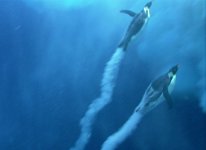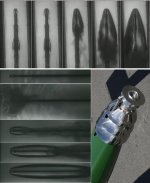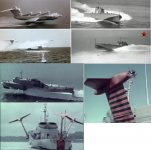According to Christopher Walken in Seven Psychopaths, you can't call them faggots anymore, they want to be adressed as homo's.
(sorry, another fag joke)
https://www.youtube.com/watch?v=O-_GjfwLn7w
(sorry, another fag joke)
https://www.youtube.com/watch?v=O-_GjfwLn7w
Can anybody tell me if the bernoulli effect is applicable to an incompressible media such as water?
Yes, in fact, for the classic equation to hold straight on, fluid has to be incompressible (*).
The only other assumption is that friction due to viscosity has to be very small.
I expect Jacco will chime in for to give a helping hand if you have some questions for the case of very low static pressure (very high fluid velocities).
George
(*) It is that gases are not incompressible
Yet, Jcx’s link is good, thanks!
Last edited:
for the case of very low static pressure
Make it fast enough, and even Navier-Stokes is not 1-on-1 applicable.
PTL for wind tunnels and towing tanks.
(surface drives generate wind, vented surfaces drives make use of that effect. https://www.youtube.com/watch?v=Of1RY4M8VqM )
Make it fast enough, and even Navier-Stokes is not 1-on-1 applicable.
PTL for wind tunnels and towing tanks.
(surface drives generate wind, vented surfaces drives make use of that effect. https://www.youtube.com/watch?v=Of1RY4M8VqM )
Those surface drives are fun to watch. I've spent my entire life watching the Unlimited Hydroplane Races here in Seattle. At speed, they're driven by the very tip of the propeller. As a local boy, I've known a number of the drivers, designers as well as crew members during my life-time.
Best Regards,
TerryO
Make it fast enough, and even Navier-Stokes is not 1-on-1 applicable.
PTL for wind tunnels and towing tanks.
(surface drives generate wind, vented surfaces drives make use of that effect.
Yes, I was implying cavitation issues at very low (or negative) pressures.
I didn’t expect anything lesser from you as a stimulating reply.
MARINE PROPULSION SYSTEM
Marine vessel with propeller
Propeller tunnel baffle and method
But I was unable to trace the initial patent from W. Albert Hickman
George
According to Christopher Walken in Seven Psychopaths[/url]
Mr. Walken has made a career of playing psychos.
You just have go with what you good at. As Clint said Man's just got to know his limitations.Mr. Walken has made a career of playing psychos.

cavitation issues
You've probably seen pictures of Juliet Marine's Ghost stealth vessel in the papers.
Each of it's submerged buoyancy hulls has two counter-rotating supercavitating props mounted on the front, which dress the surface of the hulls in a shower of air bubbles.
The air reduces the drag of the hulls to a fraction of the wetted surface, which enables the vessel to reach speeds of up to 60mph, fully stable.
The Ghost basically rides on air, has two wings, and uses flaps for steering.
Pretty close to flying.
http://www.dgiwire.com/wp-content/uploads/2014/05/Ghost-Flag.jpg
Still, it takes man millions of dollars to do what a penguin can do with a deep breath and an ingenious coat of feathers, if it's in a bit of a rush on the dinner highway.

Attachments
Here's a clip of a few Unlimited Hydros. They use jet turbine engines and often hit over 200 mph on the straightaways!
Unlimited Hydroplane Powerboat APBA Gold Cup - YouTube
Best Regards,
TerryO
Unlimited Hydroplane Powerboat APBA Gold Cup - YouTube
Best Regards,
TerryO
I went up to Washington the past 2 years and watched them run.... must be more than 3000 HP... maybe stock is 3000. ??
Back in the day -- when pistons wre supreme.... there was a 4 engine Unlimited with blown hemi engines. And, the Allison aircaft engines with turbo and nitrous.... these produced more thn 3000 HP but were not as fast as the turbins of today. Granted other refinements have been made, too. They are always great fun to watch if you like Hi-Tech.
thx-RNMarsh
Back in the day -- when pistons wre supreme.... there was a 4 engine Unlimited with blown hemi engines. And, the Allison aircaft engines with turbo and nitrous.... these produced more thn 3000 HP but were not as fast as the turbins of today. Granted other refinements have been made, too. They are always great fun to watch if you like Hi-Tech.
thx-RNMarsh
Last edited:
I went up to Washington the past 2 years and watched them run.... must be more than 3000 HP... maybe stock is 3000. ??
Back in the day -- when pistons wre supreme.... there was a 4 engine Unlimited with blown hemi engines. And, the Allison aircaft engines with turbo and nitrous.... these produced more thn 3000 HP but were not as fast as the turbins of today. Granted other refinements have been made, too. They are always great fun to watch if you like Hi-Tech.
thx-RNMarsh
The boats are much quicker than they used to be. Improved hull desighs and the reliability of the gear has improved as well. The piston driven Allisons and Rolls-Merlins were slower to accelerate than the turbines of today. A Turbo- charger on a piston engine is much slower to accellerate than the same engine with a Supercharger. Coming out of a turn they had to "be on their power curve" to accellerate down the length of the course.
Best Regards,
TerryO
You've probably seen pictures
I’ve looked and looks impressive, I looked further, there is a long history behind it.
US Navy operated hydrofoils and jetfoils for V>40knots since 1963 (supplied by Boeing and Grumman).
At that time, USSR was much more advanced (R. E. Alekseev achievements since 1950).
Supercavitation R&D started in USSR ~1960, Result: VA-111 (your penguin?). In USA Gen. Dyn. (Supramar AG)~1970
George
Attachments
The turbines are quiet-- like racing electric cars. The engines are really small as well. But just look at the size of the air intake alone tells you it is making some BIG power numbers. Those are not stock engines. Hi-Tech racing is the best. Like Hi-Tech audio or anything else.
-RM
-RM
Last edited:
The unlimited hydros are cool but I love the sound of the piston Rolls Royce Merlins.
I agree.
The deep throated sound of the piston engines was great and is much missed by all that grew up with it in the old days of the Gold Cup!
Best Regards,
TerryO
That's not an engine ... this is an engine, http://www.youtube.com/watch?v=DruAUxV9kaI ...The unlimited hydros are cool but I love the sound of the piston Rolls Royce Merlins.
Last edited:
The turbines are quiet-- like racing electric cars. The engines are really small as well. But just look at the size of the air intake alone tells you it is making some BIG power numbers. Those are not stock engines. Hi-Tech racing is the best. Like Hi-Tech audio or anything else.
-RM
These turboshaft engines are decommissioned aircraft Auxiliary Power Units (APUs).
The HF noise attributed to the compressor is attenuated by the Inlet plenum chamber.
The main -very broadband- strong exhaust turbine noise is directed aft or aft-upwards by the exhaust duct.
Thus, that noise becomes less offensive to the spectators as the strongly perceived mid-high freq components are diverted away from them and spread into 4pi space.
Direction diversion and distance do not make the low and very low freq components weaker, but human ear is much more insensitive to them, while our nerves are not.
The mechanic and the vehicle driver (usualy one and the same person) are exposed to large amounts of sub, sonic and super sonic acoustic energy, I am not exaggerating the case.
George
- Status
- Not open for further replies.
- Home
- Member Areas
- The Lounge
- John Curl's Blowtorch preamplifier part II


